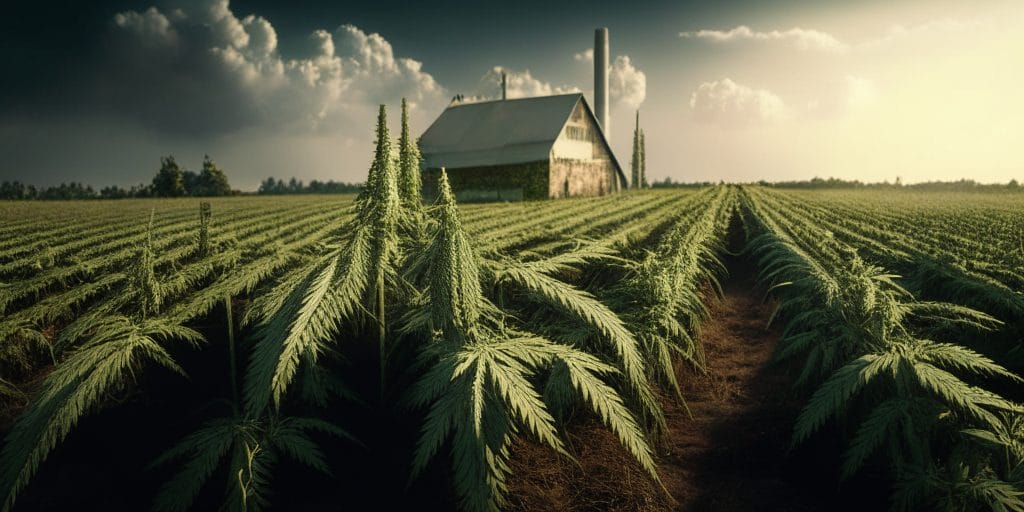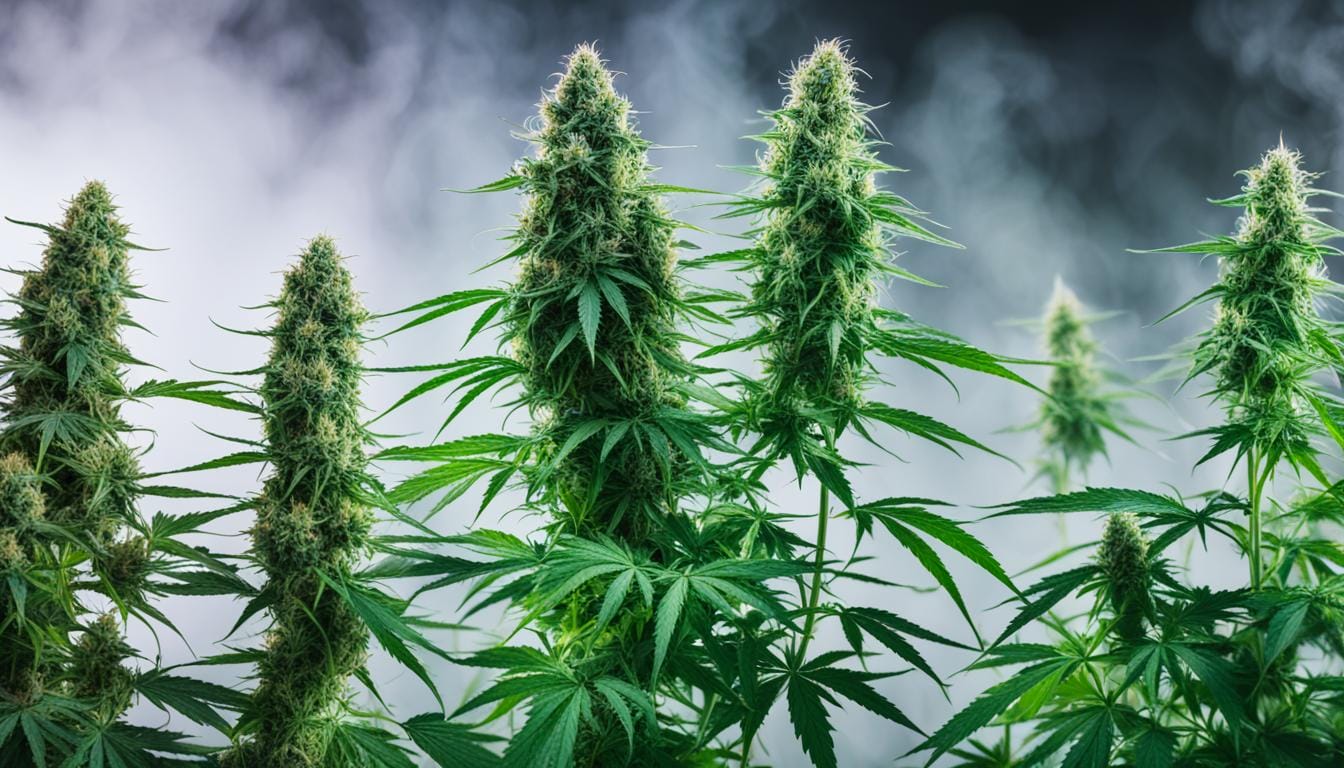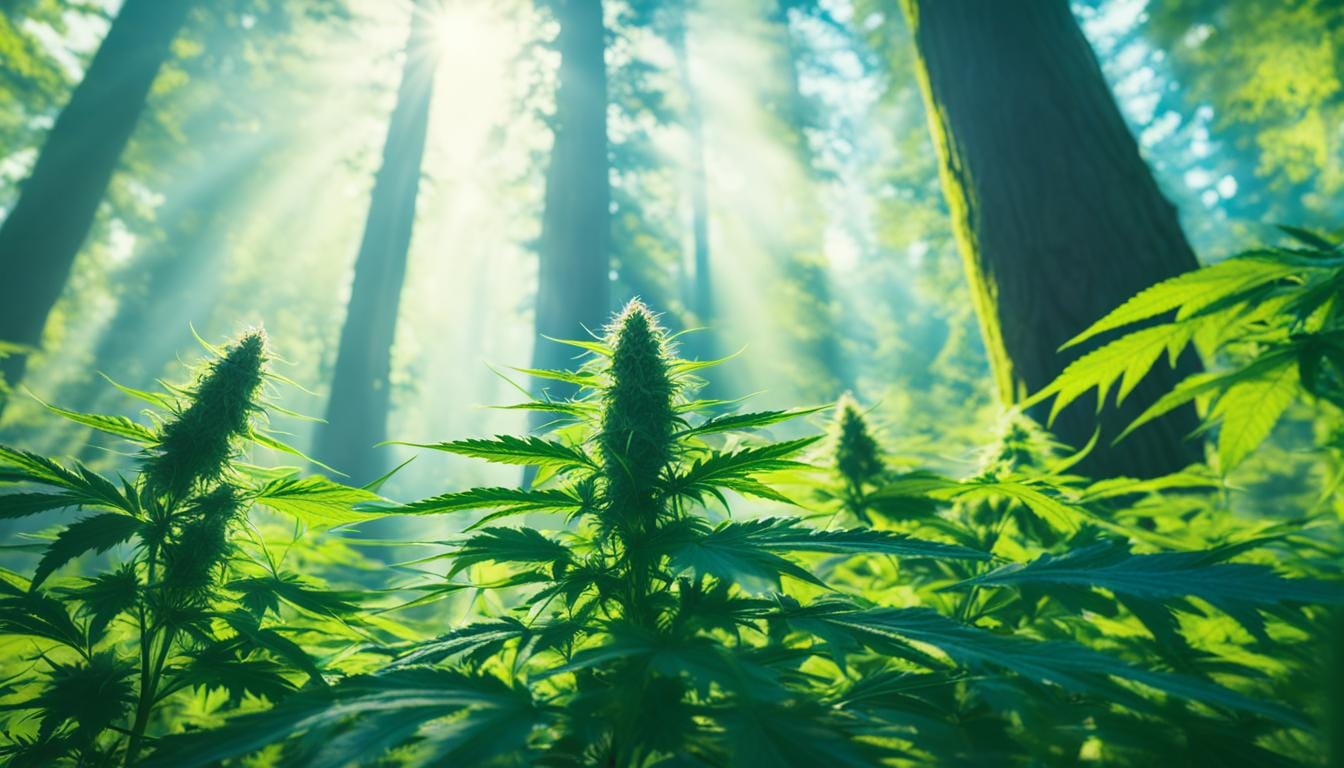Introduction to AI in Agriculture The integration of Artificial Intelligence (AI) into agriculture is no longer a futuristic concept but a transformative reality. In the realm of agriculture, AI’s potential to optimize processes, maximize yields, and sustain environmental resources is unparalleled. This is especially pertinent in specialized sectors such as cannabis cultivation, where precision and […]
Introduction to Industrial Hemp Farming

The cultivation of industrial hemp has gained significant attention since the implementation of the 2018 U.S. Farm Bill, which recognized its commercial viability. Whether you’re a seasoned farmer looking to diversify your crops or a newcomer interested in the booming hemp market, industrial hemp farming offers a promising opportunity for success.
Industrial hemp is a versatile crop with various uses in industries such as textiles, construction, paper, and food. With the right cultivation practices and knowledge, you can harness the full potential of hemp seeds and maximize your yield. From soil requirements to crop rotation strategies, there are specific factors to consider that can make a significant impact on your hemp farming venture.
In this article, we will delve into the world of industrial hemp farming, exploring topics such as the history and uses of hemp, field practices for organic cultivation, climate and soil requirements, choosing the right hemp variety, planting and seeding methods, fertilizer and weed management, the hemp market, and the challenges farmers may face.
Key Takeaways:
- Industrial hemp seeds hold great potential for boosting yield and profit in hemp farming
- Industrial hemp is a versatile crop used in industries such as textiles, construction, paper, and food
- Proper cultivation practices and knowledge are essential for maximizing hemp seed yield
- Topics covered in this article include the history and uses of hemp, organic field practices, climate and soil requirements, choosing the right hemp variety, planting and seeding methods, fertilizer and weed management, the hemp market, and potential challenges
What is Industrial Hemp?
Industrial hemp, scientifically known as Cannabis sativa L., is a variety of cannabis plants that contain less than 0.3% tetrahydrocannabinol (THC). It is important to note that industrial hemp is distinct from medical or recreational marijuana, which contains higher levels of THC.
Industrial hemp is an annual crop that can grow up to 6 meters tall. It produces male and female flowers on separate plants and is photoperiod sensitive, meaning it responds to changes in day length. This characteristic is crucial for the successful cultivation of industrial hemp.
The applications of industrial hemp are vast, making it a valuable crop in various industries. The fibers and seeds of industrial hemp are used in the production of textiles, construction materials, paper, and even food products.
The Benefits of Industrial Hemp Cultivation:
- Industrial hemp is a sustainable crop that requires fewer pesticides and fertilizers compared to other crops.
- It has a short growing cycle, allowing for multiple harvests per year.
- Industrial hemp can act as a valuable rotational crop, improving soil health and reducing pests and diseases in subsequent crops.
“Industrial hemp is a versatile plant that offers numerous economic and environmental benefits. Its cultivation can contribute to sustainable practices and provide farmers with new opportunities.”
| Key Characteristics of Industrial Hemp | Uses |
|---|---|
| Low THC content | Fiber production for textiles and construction materials |
| Annual crop | Seed production for food products |
| Photoperiod sensitive | Paper production |
History and Uses of Hemp
Hemp has a rich historical significance and has been utilized for various purposes for thousands of years. Cultivated in China, Europe, and the United States, hemp was valued for its strong fibers that were used to create clothing, rope, and paper. However, during the 20th century, the production of hemp declined due to the introduction of cotton and tobacco as more popular alternatives.
Despite this decline, hemp production has been experiencing a revival with the changing legal status of the plant. Today, hemp is utilized in a wide range of industries, including textiles, industrial products, food, and personal care products. Its fibers are known for their strength and durability, making hemp an excellent choice for clothing and construction materials. Additionally, hemp seeds are highly nutritious and can be utilized in the production of oil, protein powder, and other food products.
Furthermore, hemp has gained popularity in the beauty and personal care industry due to its moisturizing and nourishing properties. Hemp oil is commonly used in skincare products, such as lotions and balms, providing hydration and promoting healthy skin. The versatility of hemp and its various applications make it a valuable and sustainable crop with great potential in numerous industries.
“Hemp has a long-standing history and has been used for centuries for its versatile fibers and seeds. From clothing and construction materials to food and skincare products, the uses of hemp are vast and varied. With the recent resurgence of hemp production, this renewable resource is once again gaining attention and recognition for its economic and environmental benefits.”
Common Uses of Hemp
| Industry | Applications |
|---|---|
| Textiles | Clothing, accessories, fabrics |
| Construction | Building materials, insulation |
| Paper | Stationery, packaging materials |
| Food | Hemp seeds, oil, protein powder |
| Personal Care | Skincare, hair care, body care |
| Industrial Products | Bioplastics, biofuels, composites |
As the demand for sustainable and eco-friendly materials continues to grow, hemp production offers a viable solution. Its ability to be grown without the need for synthetic chemicals or excessive water makes it an environmentally friendly alternative to other crops. By embracing hemp and its multitude of uses, we can foster a more sustainable future while enjoying the many benefits this versatile plant has to offer.
Field Practices for Organic Hemp
Organic hemp farming requires specific field practices and management techniques to ensure successful cultivation. Since synthetic chemicals are not permitted in organic farming, alternative methods must be used for weed control and pest management. Additionally, choosing the right hemp cultivar, implementing proper planting methods, and managing fertilizers are crucial considerations for organic hemp farmers.
Organic Certification Standards
To maintain organic certification, farmers must adhere to specific standards set by certifying bodies. These standards include using organic seeds, avoiding the use of synthetic pesticides and fertilizers, and implementing sustainable farming practices. Organic hemp farmers need to keep detailed records of their farming practices and undergo regular inspections to maintain their organic certification.
Crop Rotations for Soil Health
Implementing crop rotations is essential for maintaining soil health and reducing pests and diseases in organic hemp farming. By rotating hemp with other crops such as legumes, grains, or vegetables, farmers can break pest and disease cycles and improve soil fertility. Crop rotations also help in weed management by disrupting weed growth and reducing weed pressure on hemp plants.
| Benefits of Crop Rotations | Examples of Crops for Rotation |
|---|---|
| Improved soil structure and fertility | Legumes (such as clover and peas) |
| Reduced pest and disease pressure | Grains (such as wheat and barley) |
| Enhanced nutrient cycling | Vegetables (such as beans and carrots) |
By implementing crop rotations, organic hemp farmers can improve their soil health, reduce the reliance on synthetic inputs, and promote sustainable farming practices.
Weed Control in Organic Hemp Farming
Weed control is a significant challenge in organic hemp farming. Without the use of synthetic herbicides, farmers need to rely on mechanical methods and proper crop rotations to manage weeds effectively. Cultivating the soil between rows and within the hemp field can help control weeds. Mulching with organic materials, such as straw or wood chips, can also suppress weed growth.
In conclusion, organic hemp farming requires careful planning and attention to field practices. Adhering to organic certification standards, implementing crop rotations, and effectively managing weeds are crucial for successful organic hemp cultivation. These practices ensure the production of high-quality organic hemp while promoting sustainable and environmentally friendly farming techniques.
Climate and Soil Requirements for Hemp
Hemp cultivation requires specific climate and soil conditions to ensure optimal growth and yield. Understanding these requirements is crucial for successful hemp farming.
Climate Requirements
When it comes to climate, hemp thrives in mild, sub-tropical regions with temperatures above 45°F for germination and 65°F for growth. It is important to note that hemp is a heliophile crop, meaning it requires at least 6 hours of daily sunlight to achieve optimal growth and development.
- Hemp prefers regions with at least 25 to 35 inches of annual rainfall or reliable irrigation systems in place.
- The crop is highly adaptable to different climates, but it is sensitive to frost. Therefore, it is recommended to avoid areas prone to late spring frosts or early winter frosts.
By ensuring the right climate conditions, farmers can provide hemp plants with the necessary environment to flourish and maximize their yield potential.
Soil Requirements
The choice of soil for hemp cultivation is equally important. Hemp prefers well-drained soil with a pH level between 6.0 and 7.5. It is essential to avoid waterlogged or compacted soil, as it can hinder root development and impact overall plant health.
Hemp can tolerate a wide range of soil types, including sandy, loamy, or clayey soils. However, it thrives in deep, fertile soils that offer good water retention and nutrient availability.
Additionally, incorporating organic matter into the soil can enhance its fertility and improve the overall health of hemp plants. Regular soil testing is recommended to monitor nutrient levels and ensure adequate soil composition.
| Climate Requirements for Hemp | Soil Requirements for Hemp |
|---|---|
| Mild, sub-tropical climate | Well-drained soil with a pH between 6.0 and 7.5 |
| Minimum temperatures above 45°F for germination | Preferably deep, fertile soils |
| Minimum temperatures above 65°F for growth | Good water retention and nutrient availability |
| At least 6 hours of daily sunlight | Avoid waterlogged or compacted soil |
| At least 25 to 35 inches of annual rainfall or reliable irrigation | Tolerant to different soil types (sandy, loamy, clayey) |
Understanding the climate and soil requirements for hemp cultivation is essential for farmers to optimize their crop’s growth and maximize yield potential. By providing the ideal climate conditions and ensuring proper soil composition, farmers can set the stage for successful hemp farming.
Choosing the Right Hemp Variety
When it comes to hemp farming, selecting the right variety is crucial for maximizing your yield and meeting market demands. There are three main types of hemp varieties: fiber hemp, seed hemp, and dual-purpose hemp. Each variety has its own unique characteristics and uses, so understanding the differences is essential.
Fiber hemp is specifically bred for its long and strong fibers, which are used in the textile and construction industries. This variety typically has lower seed yields but higher fiber yields. Fiber hemp requires a higher plant density and more intensive management to achieve optimal fiber quality.
Seed hemp, on the other hand, is cultivated for its seeds, which can be used for oil production, food products, and as a nutritional supplement. Seed hemp varieties have higher seed yields and generally require less nitrogen and fewer growing degree days compared to fiber hemp.
Dual-purpose hemp is a hybrid variety that is bred to have both high fiber and seed yields. This type of hemp requires specialized management and harvesting machinery to effectively harvest both fiber and seeds. Dual-purpose hemp can be a viable option for farmers looking to diversify their product offerings.
Fiber Hemp vs Seed Hemp vs Dual-Purpose Hemp
| Hemp Variety | Characteristics | Uses |
|---|---|---|
| Fiber Hemp | High fiber yield, lower seed yield | Textiles, construction |
| Seed Hemp | Higher seed yield, lower fiber yield | Oil production, food products |
| Dual-Purpose Hemp | High fiber and seed yields | Diverse product offerings |
When choosing a hemp variety, consider factors such as market demand, processing facilities, and your specific farming conditions. It’s essential to conduct thorough research and consult with experts in the hemp industry to make an informed decision. By selecting the right hemp variety, you can optimize your yield, meet market demands, and achieve success in the rapidly growing hemp industry.
Hemp Planting and Seeding Methods
Planting and seeding methods play a crucial role in the successful cultivation of industrial hemp. Depending on the farm’s specific requirements and resources, different techniques can be employed to ensure optimal plant growth and yield. Let’s explore some common approaches to hemp planting and seeding:
Direct Drilling
Direct drilling, also known as drilling or direct seeding, involves placing the hemp seeds directly into the soil using a seed drill. This method is efficient and allows for precise seed placement, ensuring uniform emergence and plant density. It is commonly used in large-scale industrial hemp farming operations. However, it requires specialized equipment and may not be suitable for all farmers.
Broadcast Seeding
Broadcast seeding involves scattering hemp seeds evenly across the soil surface. This method is less precise compared to direct drilling, but it can be a viable option for smaller-scale or organic farming operations. After broadcasting the seeds, farmers can lightly cultivate the soil or roll it to ensure good seed-to-soil contact. It’s important to note that broadcast seeding may result in slightly lower plant density and less uniform emergence.
Planting Equipment
When it comes to planting hemp, various types of equipment can be utilized depending on the chosen seeding method. For direct drilling, a seed drill is the most common tool used, which can be adjusted to achieve the desired seeding rate and depth. For broadcast seeding, a spinner spreader or a cyclone seeder can be used to evenly distribute the seeds. It’s crucial to clean and maintain the planting equipment properly to avoid cross-contamination and ensure consistent and successful hemp planting.
| Planting Method | Pros | Cons |
|---|---|---|
| Direct Drilling | Precise seed placement, uniform emergence and plant density | Requires specialized equipment |
| Broadcast Seeding | Suitable for smaller-scale or organic farming operations | Lower plant density, less uniform emergence |
Choosing the appropriate planting method and equipment is essential for successful hemp cultivation. Farmers should consider factors such as farm size, available resources, and specific cultivation goals when making these decisions. By employing the right techniques and equipment, farmers can maximize their hemp crop’s potential and ensure a successful harvest.
Fertilizer and Weed Management for Hemp
Proper management of fertilizers and weeds is crucial for successful hemp farming. In this section, we will discuss effective fertilizer management strategies and weed control measures for hemp cultivation.
Fertilizer Management
Fertilizer management for hemp should be based on the nutrient requirements of the crop and the specific characteristics of the soil. Conducting a soil test is essential to determine the nutrient levels and pH of the soil. This information will guide you in applying the right amount and type of fertilizers.
Nitrogen is a key nutrient for hemp and can significantly impact biomass and seed yield. Organic sources of nitrogen, such as leguminous cover crops, can be beneficial for hemp cultivation. These cover crops fix atmospheric nitrogen, providing a natural and sustainable source of nutrients for hemp plants.
It is important to note that herbicides are currently not labeled for use on hemp. Therefore, reliance on organic methods, such as mechanical weed control and crop rotations, becomes essential to manage weed growth effectively.
Weed Control Measures
Hemp farming, especially in organic systems, requires effective weed control measures. Mechanical cultivation, such as hoeing or harrowing, can be employed to control weeds within rows. It is crucial to remove weeds early in the growing season to prevent competition for resources.
Crop rotations are another valuable tool in weed management. By rotating hemp with different crops, you can disrupt the life cycles of weeds and reduce their populations over time. This can be particularly effective in organic farming systems where herbicides are not used.
Taking a proactive approach to weed management is essential in hemp cultivation. Regular scouting and timely intervention can help prevent weed infestations and ensure the healthy development of your hemp crop.
| Effective Fertilizer Management for Hemp | Weed Control Measures for Hemp |
|---|---|
| – Conduct soil tests to determine nutrient levels and pH | – Implement mechanical cultivation methods |
| – Apply organic nitrogen sources, such as leguminous cover crops | – Practice timely weed removal |
| – Consider the nutrient requirements of the specific hemp variety | – Opt for crop rotations to disrupt weed life cycles |
| – Monitor plant nutrient deficiencies and adjust fertilizer applications accordingly | – Scout regularly to identify weed species and populations |
By implementing effective fertilizer management and weed control measures, hemp farmers can optimize the growth and productivity of their crops and ensure a successful harvest.
Industrial Hemp Market and Challenges
The industrial hemp market is experiencing significant growth due to the increasing demand for hemp-derived products in various industries such as textiles, construction, paper, and food. The versatility of hemp and its potential as a sustainable and eco-friendly resource have attracted both consumers and businesses. According to market research, the global industrial hemp market is expected to reach a value of $18.6 billion by 2025, with a compound annual growth rate of 22.2%.
However, hemp farmers face several challenges in this rapidly expanding market. One of the main challenges is the lack of infrastructure and processing facilities for hemp crops. With the resurgence of hemp production, there is a growing need for efficient harvesting, drying, and processing equipment. The limited availability of such machinery can hinder the scalability of hemp farming operations.
Another significant challenge is the evolving legal and policy landscape surrounding hemp cultivation. While industrial hemp cultivation is legal at the federal level in the United States, individual states may have different regulations and restrictions. This creates a complex and uncertain environment for hemp farmers, who need to navigate through varying rules and licensing requirements.
| Market Challenges | Impact on Hemp Farmers |
|---|---|
| Limited processing infrastructure | Hinders scalability and profitability |
| Fluctuating legal and policy landscape | Creates uncertainty and compliance challenges |
| Market competition | Requires strategic positioning and differentiation |
| Lack of access to financing | Restricts investment in equipment and operations |
“The industrial hemp market offers substantial opportunities for farmers, but it is essential to be prepared for the challenges that come with it. By staying informed about the latest regulations, forming strategic partnerships, and investing in necessary infrastructure, hemp farmers can position themselves for success in this growing market.”
Strategies for Success in the Industrial Hemp Market
- Research and understand the market demand for hemp-derived products to identify niche opportunities
- Establish strong relationships with processors, manufacturers, and retailers to secure a reliable supply chain
- Stay updated on the evolving legal and policy landscape to ensure compliance and mitigate risks
- Differentiate products through quality, certifications, and innovative processing methods
- Explore alternative financing options and grants to overcome capital constraints
Despite the challenges, the industrial hemp market presents a promising opportunity for farmers to diversify their crop portfolio and contribute to a sustainable future. With strategic planning and proactive measures, hemp farmers can navigate the market dynamics and establish themselves as key players in this emerging industry.
Conclusion
Industrial hemp farming offers a promising opportunity for farmers to diversify their crops and tap into a growing market demand for hemp products. By following proper field practices, selecting the appropriate hemp variety, and effectively managing fertilizer and weed control, farmers can maximize their yield and contribute to the sustainability of this industry.
Although there are challenges in the market and uncertainties in policy and regulations, the potential benefits of industrial hemp farming make it a worthwhile venture for those willing to invest time and effort into research, planning, and establishing supply chains. By staying informed about market trends and securing necessary permits, farmers can position themselves for success in this competitive landscape.
As the recognition of hemp as a commercial crop continues to grow, it is important for farmers to keep abreast of the ever-changing legal and policy landscape surrounding hemp cultivation and CBD extraction. By staying informed and adapting to these changes, farmers can navigate potential obstacles and ensure the profitability of their hemp farming operations.
Indeed, industrial hemp farming holds great promise for farmers looking to explore new avenues of agricultural production. By leveraging the benefits of this versatile and sustainable crop, farmers can not only boost their yield but also contribute to the demand for hemp products in various industries. With careful planning, management, and a proactive approach to market challenges, industrial hemp farming can open doors of opportunity and pave the way for a prosperous future in agriculture.
FAQ
What is industrial hemp?
Industrial hemp is a variety of Cannabis sativa L. that contains less than 0.3% THC. It is different from medical or recreational marijuana, which contains higher levels of THC. Industrial hemp is grown for its fibers and seeds and is used in various industries such as textiles, construction, paper, and food.
What is the history of hemp?
Hemp has a long history and has been used for fiber production for thousands of years. It was cultivated in China, Europe, and the United States for various purposes including clothing, rope, and paper. In the 20th century, hemp production declined due to the introduction of cotton and tobacco. However, with the changing legal status, hemp production has begun to revive.
What are the field practices for organic hemp farming?
Organic hemp farming requires careful planning and management. Synthetic chemicals are not permitted, so weed control and pest management must be approached organically. Choosing a suitable hemp cultivar, proper planting methods, and fertilizer management are important considerations. Crop rotations can help maintain soil health and reduce pests and diseases.
What are the climate and soil requirements for hemp?
Hemp is adapted to well-drained soil with a pH between 6.0 and 7.5. It prefers mild, sub-tropical climates with temperatures above 45°F for germination and 65°F for growth. Hemp requires at least 25 to 35 inches of annual rainfall or irrigation. It is a heliophile crop and requires at least 6 hours of daily sunlight for optimal growth.
How do I choose the right hemp variety?
There are hundreds of hemp varieties available, bred specifically for fiber or seed production. The choice of variety depends on the end use and the environment. Seed-type hemp requires less nitrogen and longer growing degree days compared to fiber-type hemp. Market opportunities and processing facilities should be considered when selecting a variety. Dual-purpose hemp can be grown, but it requires specialized management and harvesting machinery.
What are the planting and seeding methods for hemp?
Hemp can be planted using drilling or broadcast seeding methods. Tillage is the conventional method for preparing the field, but no-till methods can also be used with proper weed control measures. Planting depth should be ½ to ¾ inches, and hemp can be planted between mid-May and mid-June. Seeding rates depend on the variety and target plant density. Hemp can be planted in rows or with a grain drill. Planting equipment should be cleaned after use to avoid cross-contamination.
How do I manage fertilizer and weeds for hemp?
Nutrient requirements for hemp should be determined by a soil test. Nitrogen fertilization can increase biomass and seed yield, and leguminous cover crops can provide adequate nitrogen without additional fertilization. Weed management is important for hemp production, especially in organic farming. Mechanical weed control methods should be used in rows or no-till systems, and proper crop rotation can help reduce weed pressure. Herbicides are not currently labeled for use on hemp.
What are the challenges in the industrial hemp market?
The market for hemp products is competitive, both domestically and globally. Potential hemp farmers should carefully research the market, secure necessary permits, and establish supply chains before starting production. The current legal and policy landscape regarding hemp cultivation and CBD extraction is fluid and can impact the profitability and success of hemp farming.
Back





